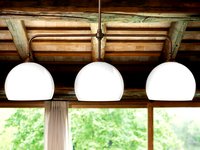XXVI
INDUSTRIAL & URBAN LIGHTING
Crest current
Combined pulse
25 kA
25 kV
20 kA
20 kV
15 kA
15 kV
10 kA
10 kV
0 kA
0 kV
0
50
100
150
200
250
300
350
400
t µs
SPD
These days, with the ever-increasing use of electrical equipment and with the exponential increase of the level of
semiconductor integration, more and more attention is given to the phenomena related to transitory surge voltage of
atmospheric origins and surge voltage due to electrical switching on distribution systems because of the substantial
economic damage that they can cause. There is consequently a need to adopt increasingly greater safety measures
inside building and system infrastructures in order to ensure that the electrical and electronic equipment is not
damaged and can provide its performance, even in the presence of interferences. The SPDs, depending on the
parameters of the lighting current pulse they are called upon to discharge to earth, are tested and then classified in
different ways. The IEC 61643-11 Ed.1 (2011-03) standard and the corresponding CEI EN 61643-11/A11 standard,
although using different, but substantially identical definitions, divide them up as follows:
IEC 61643-11
(2011-03)
CEI EN
61643-11/A11
SPD
WAVE
FORM
DISCHARGE
CURRENT
COMBINED
PULSE
Class 1 SPD
Type 1 SPD T
SPD for lightning
current
Tested with limp pulse current (10/350 µs)
and with the nominal In discharge current (8/20 µs)
10/350 μs
limp 25 kA
-
Class 2 SPD
Type 2 SPD T
Overvoltage
limiter
Tested with nominal In discharge current (8/20 µs) and with maxi-
mum Imax discharge current (8/20 µs). The Imax, nevertheless,
is neither useful nor usable to choose the SPD
8/20 μs
limp 20 kA
-
Class 3 SPD
Type 3 SPD T
Overvoltage
limiter
Tested with the combined generator
that applies Uoc no-load voltage (1,2/50 µs)
and in short circuit a presumed In current (8/20 µs)
1,2/50 μs
-
10 kV
Overvoltage 45%
Undefined causes 14%
Other causes 41%
DAMAGE TO THE
ELECTRONICS
IN SPD
OVERVOLTAGE LIMITERS
SPD







